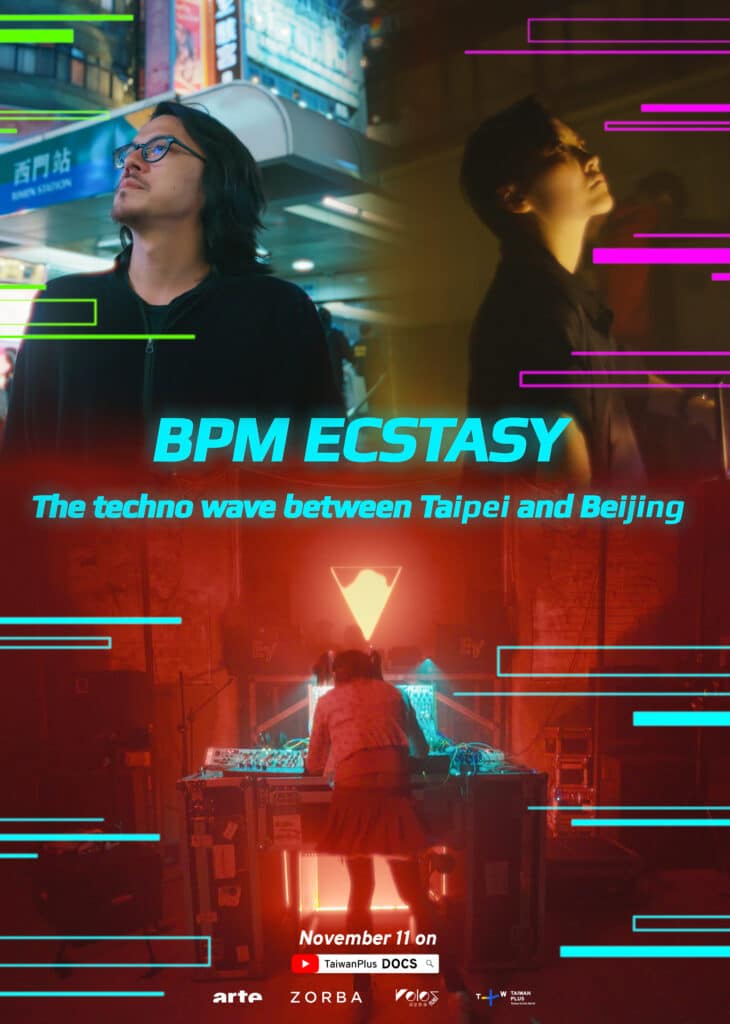Olivier Richard, Director of BPM Ecstasy, discusses the four-part docuseries and why bridging culture matters to music.
Five minutes into the first episode of BPM ECSTASY are flashing shots of Taiwan’s underground dance community illuminated the faces of club-goers who gathered in the bustling local venues. Inside these hidden enclaves, darkness was punctuated by strobes of vibrant colors as the backdrop blended familiarity with the storied techno scene of rave capitals such as Berlin and Amsterdam.
The docuseries, officially titled BPM ECSTASY: The Techno Wave Between Taipei and Beijing, is a riveting narrative presented by TaiwanPlus and ARTE in partnership with ZORBA and Volos Films. As the first-of-its-kind Taiwanese-French collaborative project, the four-part docuseries peel back the layers of techno underground subculture in Taiwan and Beijing to offer viewers an exclusive opportunity to explore the communal spirit found within these concealed spaces.
Visionary Director Olivier Richard aims to capture the yearning aspirations of several talented local artists such as SUNK, tamiX, Elvis. T, and more to give the audiences a front-row seat to the behind-the-scenes of the state of DJ-ing in a post-pandemic world. In the wake of its premiere, we were delighted to chat with him about his experience working on the production, the distinct subcultures between Taiwan and Beijing, and the future of techno music in these markets.
BPM Ecstasy looks to bridge unique subcultures while fostering a sense of international community.
From scenes of anticipation outside the discreet club venues to the revelation of an immersive haven within, the series captures a universal language spoken in electronic music. Local DJs crafted pulsating beats that could easily transport one to the heart of the famed European techno venues while asserting their own distinct identity through a local sound.
Emphasizing the series’ importance for celebrating diversity and nurturing an international community, Richard says, “I knew that Taipei housed many interesting artists, what struck me is the connection between Taiwan and Beijing. Beyond ideas caused by the political situations, people didn’t stop to exchange ideas. The film allows us to see the things happening between these regions and their connection to each other.”
In Taiwan, what is interesting is their indigenous culture.They are fascinating and it is interesting to see the connection between Indigenous Taiwan and the Pacific.
Olivier Richard
At the heart of Taiwan’s pulsating techno scene lies a dynamic convergence of music, culture, and energy.
As each local artist narrated their experiences grappling with self-discovery throughout their career, the series also unraveled the profound implications of being a techno artist in Asia following the wake of the COVID-19 pandemic. However, their fervent voices conveyed their passion for the music and highlighted their vast aspirations of elevating the techno culture in their local community.
Richard offered his views on their deep-seated commitment to the art of DJing. He said, “Taiwan is very westernized. They have a very positive crowd and audience. The independent club scene is very active, although it is still small. The interesting thing is in the underground scene, they are very active, and nothing will stop them.”

Local DJs continue to navigate the challenges of the modest techno-electronic music scene.
Despite the increasing interest and vibrancy of the community, techno remains a relatively niche genre in Taiwan and China. Dwarfed by their scale of popularity witnessed in Western markets, Richard affirmed his optimism for its promising trajectory. He said, “Culturally speaking, what could help the scene to grow is to release the school pressure on kids so that they can spend more time outdoors. It is also complicated for clubs to survive because the fact is that in Taipei, the audience is still not educated on this type of music yet, so there are only a few clubs in the city to play. However, techno is still very interesting and creative!”
It is advantageous that most of the techno music has no lyrics so there are no language barriers for the people. It is easier for techno artists to see sucess than other genres who uses localised language in their music.
Olivier Richard
As the series aims to celebrate diversity and promote a sense of togetherness that the global audience can learn from, it was heartening to hear that the shared stories have also cultivated new interest in Taiwan and China’s techno community.
“There are strong ratings for the film from France and Germany. All the comments are very positive, and the audience is curious about the techno community. People were not expecting the Chinese and Taiwanese scene to be so creative,” said Olivier Richard. “The artists were also saying that they were getting more connections through this film. I’m happy to see that people are as excited as I was!”
Whether you are a techno aficionado or getting acquainted with this genre, BPM ECSTASY will be an eye-opening opportunity to learn more about the sound that is growing to form its own distinct rhythm within Taiwan and Beijing’s electronic heartbeat.
BPM ECSTASY: The Techno Wave Between Taipei and Beijing is available on TaiwanPlus Docs YouTube and ARTE’s YouTube. Watch the four-part docu-series now.

Follow TaiwanPlus:
Website | Facebook | Twitter | Instagram | YouTube








